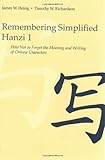I'm currently learning Chinese (using Remembering Simplified Hanzi from Heisig [0] for characters and Iknow [1] for words/pronunciation) and I find it a lot easier than I initially thought it would be. It helps a great deal to know that all these characters that look so complicated are mostly made of the same 200-some radicals [2], suddenly it's a lot less daunting and the characters even make sense most of the time. And sure, one might forget characters with lack of use, but the same can be said about other languages. Grammar is a hot topic on the internet, isn't it?
[0] http://www.amazon.co.uk/Remembering-Simplified-Hanzi-Meaning...
[1] http://iknow.jp/ (originally for Japanese, but Chinese course is excellent, too)
[2] https://sensiblechinese.com/wp-content/uploads/2015/05/Radic...
Remembering Traditional Hanzi: Book 1: http://www.amazon.com/Remembering-Traditional-Hanzi-Meaning-...
Remembering Simplified Hanzi: Book 1: http://www.amazon.com/Remembering-Simplified-Hanzi-Meaning-C...
Take your pick.


That is a terrible learning outcome. I guarentee you that if you spent the same time with Remembering {Traditional,Simplified} Hanzi [0,1] you would be able to read more than a handful of characters. You'd also have intuition for novel (zero-shot) characters.
But I do agree you should practice writing, though -- as I argued in another comment -- I think the finger tracing is more about learning character shape rather than focused on teaching to write. That part is even important for reading. Though I do think Scritter, which uses fingers, will result in decent writing skills.
[0] https://www.amazon.com/Remembering-Traditional-Hanzi-Meaning...
[1] https://www.amazon.com/Remembering-Simplified-Hanzi-Meaning-...